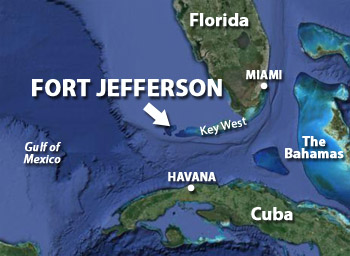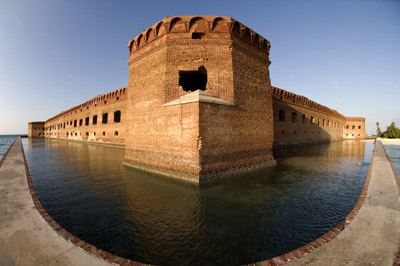 |
Fort Jefferson
Dry Tortugas, Florida
|
|
 |
Constructed: 1846-1876
Used by: USA
Conflict in which it participated: None
|
Spanish explorer Ponce de Leon (1474-1521) was the first European to see the seven islands off the Florida Keys now known as the Dry Tortugas, in 1513. He and his crew caught 160 floppy sea turtles while there, so he named the islands Las Tortugas, or the turtles. The word "Dry" was soon appended to this name on seamen's charts, to warn of a complete lack of fresh water on the islands. |
 |
 |
|
At the end of 1824, two years after the Spanish Empire had sold Florida to the United States, US Navy Commodore David Porter (1780-1843) inspected the islands to determine their possible military use. Commodore Porter wasn't particularly enthusiastic about setting up a fortification on the tiny islands without any source of fresh water, but owing to the hundreds of shipwrecks that had occurred there over the years as a result of their scary reefs, a lighthouse, known as Garden Key Light, was built there in 1825.
|
Not Garden Key Light. This lighthouse was constructed in 1858. The Dry Tortugas are a natural ship trap: Directly in the way of natural shipping lanes, they've caused hundreds of shipwrecks. |
 |
US Navy Commodore John Rodgers (1772-1838) visited the islands in 1829 and was much more impressed than Commodore Porter. Rodgers felt that the Dry Tortugas offered an excellent anchorage for ships of the line, and warned that if a foreign power (or Caribbean pirates) gained a foothold there US shipping would be in peril, and "nothing but absolute naval superiority" could drive them out. He argued that, if occupied by he US military, the islands could serve as an advance post for the defense of the Gulf Coast.
Much bureaucratic wrangling proceeded, and construction of Fort Jefferson (named for US President Thomas Jefferson (1743-1826)) finally got under way in 1846. |
|
|
Construction continued for some 30 years, and it was in active use by the military for that period of time, but Fort Jefferson was never actually finished. Even uncompleted, the end result was made of over 16 million bricks, and remains the largest masonry structure in the western hemisphere!
|
Some 2000 people lived in Fort Jefferson during its peak years. The fort remained in Federal hands during the US Civil War (1861-1865), and was used mostly as a prison for deserters. Slaves were used in the construction of the fort, but by 1863 plenty of prisoners were on hand for the performance of unpleasant tasks, so the black slaves were relieved of their duties and doubtless tossed into the sea.
In July of 1865, four men convicted of the conspiracy to assasinate US President Abraham Lincoln (1809-1865), including Dr. Samuel Mudd (1833-1883), arrived at Fort Jefferson for incarceration. Dr. Mudd somewhat redeemed himself by providing heroic medical assistance during an outbreak of yellow fever at the fort in 1867, and in 1868 he was pardoned by US President Andrew Johnson (1808-1875).
|
 |
Fort Jefferson's Hot Shot Furnace. A common sight in early-to-mid-18th-century American forts, though none were ever used for their intended purpose. This is the only one I've seen with a stylish crumbly stone roof! |
|
After the war, the military importance of Fort Jefferson lessened. It continued as a military prison until 1874, but the cost related to the upkeep of such a facility, regularly lashed by hurricanes when not being beat upon by the tropical sun, became too great. In 1888 the US Army turned the fort over to the Marine Hospital Service to be operated as a quarantine station. In 1908 the area became a wildlife refuge for protection of nesting birds from egg collectors, and in 1935 Fort Jefferson was proclaimed a National Monument.
|
 The United States National Park Service loves me so. This I know, for they provided me with this picture of Fort Jefferson's southwest bastion. Click it, it's big 'n' beautiful. |
 |
Today Fort Jefferson receives around 80,000 visitors a year. The islands are located almost 70 miles west of Key West, and are only accessible by seaplane or boat.
From the NPS website: ...the park is known the world over as the home of magnificent Fort Jefferson, picturesque blue waters, superlative coral reefs and marine life, and the vast assortment of bird life that frequent the area.
|
|
|
|
|
|
|
|
 |


